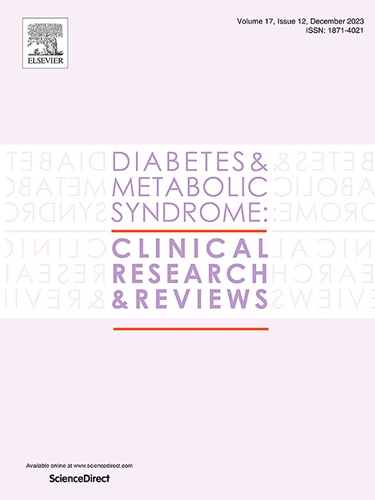西马鲁肽2.4 mg和替西帕肽5-15 mg治疗伴有或不伴有2型糖尿病的肥胖的比较疗效和安全性:一项3期临床试验的系统综述
IF 3.4
Q1 ENDOCRINOLOGY & METABOLISM
Diabetes & Metabolic Syndrome-Clinical Research & Reviews
Pub Date : 2025-03-01
DOI:10.1016/j.dsx.2025.103212
引用次数: 0
摘要
背景和目的:西马鲁肽2.4 mg和替西帕肽最近都被批准用于肥胖症的慢性治疗。目前缺乏文献比较这两种药物对伴有或不伴有2型糖尿病(T2D)的肥胖/超重患者的疗效和安全性。我们系统地回顾了两种药物进行的3期随机对照试验(rct),以综合比较疗效和安全性结果。方法系统检索PubMed电子数据库,检索时间截止到2024年12月15日。随后,我们通过调整(如果治疗结果调节因子存在基线不平衡)或未调整(在没有基线不平衡的情况下)间接治疗比较方法,比较了使用semaglutide 2.4 mg和tizepatide进行的最密切匹配的试验。结果:我们确定了在肥胖或超重无T2D患者中分别使用塞马鲁肽2.4 mg (STEP-1)和替西肽5、10和15 mg (SURMOUNT-1)的一项试验,以及在超重合并T2D患者中分别使用塞马鲁肽2.4 mg (STEP-2)和替西肽10和15 mg (SURMOUNT-2)的一项试验,这些试验在基线结局调节因子特征上几乎完全可比较。在意向治疗分析中,我们在没有个体患者数据的未经调整分析中发现,与西马鲁肽2.4 mg相比,替西帕肽10和15 mg的体重减轻相对较高(增加4%和5.4%),HbA1c降低(增加- 0.4%),胃肠道副作用(GI S/E)更少。结论替西帕肽10和15 mg比西马鲁肽2.4 mg更有效,GI S/E更低。目前需要一项强有力的头对头随机对照试验来证实这些发现。本文章由计算机程序翻译,如有差异,请以英文原文为准。
Comparative efficacy and safety of semaglutide 2.4 mg and tirzepatide 5–15 mg in obesity with or without type 2 diabetes: A systematic review of Phase 3 clinical trials
Background and aims
Both semaglutide 2.4 mg and tirzepatide have been recently approved for chronic use in obesity. There is a lack of literature comparing the efficacy and safety of both these agents in people with obesity/overweight with or without type 2 diabetes (T2D). We systematically reviewed Phase 3 randomized controlled trials (RCTs) conducted with two agents to synthesize the comparative efficacy and safety outcomes.
Methods
We systematically searched PubMed electronic databases until December 15, 2024, using selected keywords and Boolean “AND.” Subsequently, we compared the most closely matched trials conducted with semaglutide 2.4 mg and tirzepatide through an adjusted (if baseline imbalance in treatment outcome modifiers present) or unadjusted (in the absence of baseline imbalance) indirect treatment comparison method.
Results
We identified one trial each of semaglutide 2.4 mg (STEP-1) and tirzepatide 5, 10, and 15 mg (SURMOUNT-1) in obese or overweight people without T2D and one trial each of semaglutide 2.4 mg (STEP-2) and tirzepatide 10 and 15 mg (SURMOUNT-2) in overweight people with T2D that were almost entirely comparable concerning baseline outcome modifier characteristics. Our unadjusted analysis without individual patients' data found relatively higher (4 and 5.4 % additional) weight loss, HbA1c (−0.4 % additional) reduction, and fewer gastrointestinal side effects (GI S/E) with tirzepatide 10 and 15 mg, respectively, than with semaglutide 2.4 mg, in the intention-to-treat analysis.
Conclusion
Tirzepatide 10 and 15 mg are more effective and have fewer GI S/E than semaglutide 2.4 mg. A well-powered head-to-head RCT is currently needed to confirm these findings.
求助全文
通过发布文献求助,成功后即可免费获取论文全文。
去求助
来源期刊

Diabetes & Metabolic Syndrome-Clinical Research & Reviews
ENDOCRINOLOGY & METABOLISM-
CiteScore
22.90
自引率
2.00%
发文量
248
审稿时长
51 days
期刊介绍:
Diabetes and Metabolic Syndrome: Clinical Research and Reviews is the official journal of DiabetesIndia. It aims to provide a global platform for healthcare professionals, diabetes educators, and other stakeholders to submit their research on diabetes care.
Types of Publications:
Diabetes and Metabolic Syndrome: Clinical Research and Reviews publishes peer-reviewed original articles, reviews, short communications, case reports, letters to the Editor, and expert comments. Reviews and mini-reviews are particularly welcomed for areas within endocrinology undergoing rapid changes.
 求助内容:
求助内容: 应助结果提醒方式:
应助结果提醒方式:


